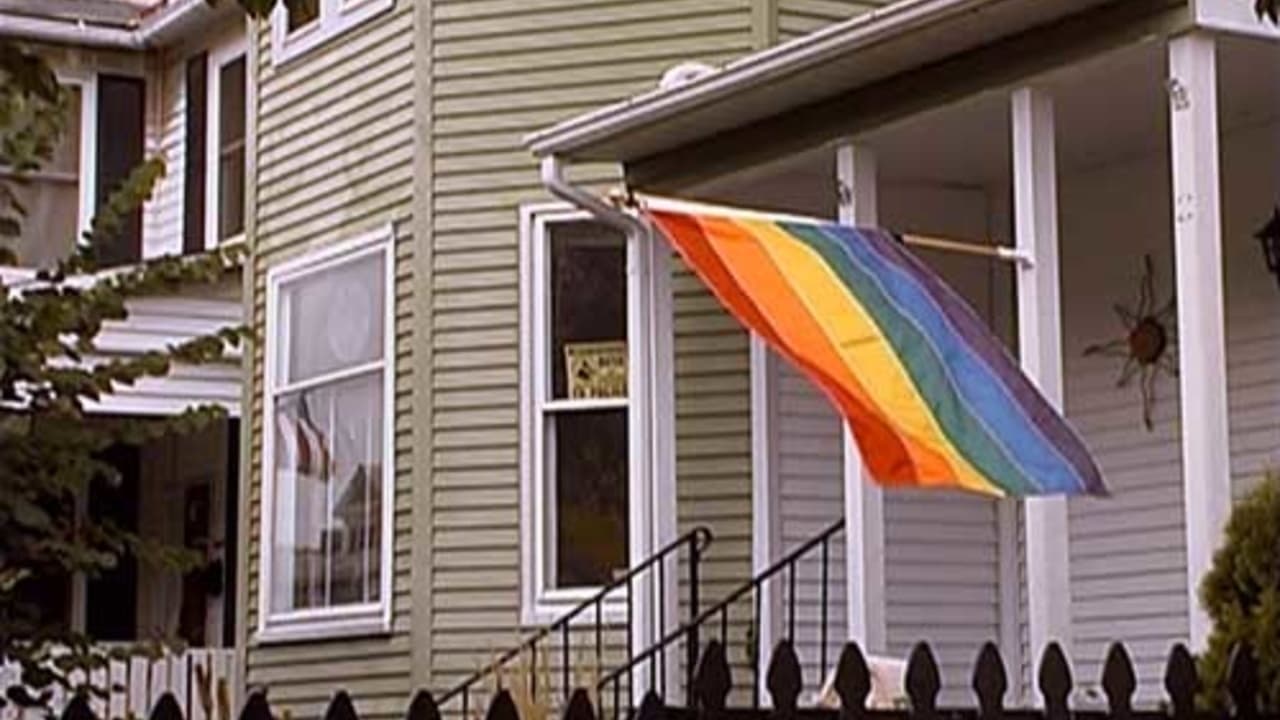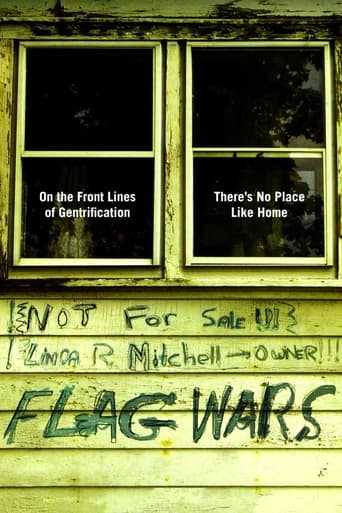

People are voting emotionally.
... View MoreInstead, you get a movie that's enjoyable enough, but leaves you feeling like it could have been much, much more.
... View Morean ambitious but ultimately ineffective debut endeavor.
... View MoreActress is magnificent and exudes a hypnotic screen presence in this affecting drama.
... View MoreFlag Wars Documentary ReviewFlag Wars is a documentary about an inner-city neighborhood east of Downtown Columbus, Ohio named Olde Towne. It once was home to Columbus' wealthiest and most influential residents such as industrialists, lawyers, teachers and architects. The area where it lies on top of was developed after the streetcar lines were extended to here from downtown Columbus. Upon this land large, opulent residences were built by the city's elite. Following the spread of automobile use starting in the 1920s the neighborhood's residents decided to move further out into suburban areas such as the City of Bexley in the search for newer, less congested housing. The hole left behind by moving residents was filled by poorer African-Americans looking for affordable housing close to the jobs available in downtown Columbus. The old, opulent homes were stripped of any valuable items and/or partitioned into apartments or nursing homes. "http://en.wikipedia.org/wiki/Olde_Towne_East." Accessed October 24, 2013. Olde Towne fell on hard economic times starting in the 1980s and was neglected up until the early 2000s during the housing boom in the United States. White Homosexual homebuyers were attracted to the neighborhood because of the cheap, beautiful, historical homes in the area. These new incoming residents in turn displaced older residents. This sort displacement has taken place in many Chicago communities such as Bucktown, Wicker Park, and Lakeview for example. One of these newcomers is a lesbian real estate agent Nina Masseria who seems to have a genuine disdain for the old time residents. The disdain could be attributed to her belief that the current residents don't appreciate what they have and their reluctance to accept the inevitable displacement of long-time residents. And of course, Nina stands to benefit financially from the continuing gentrification of the area.The documentary then shifts to Chief Obablook Baba Sonco Obadina a long-time resident who is a local handyman and artist. Chief Obadina has been ordered by the city of Columbus to take down a sign on the front entrance of his home which he has carved himself. The sign bears his name and address but, is not in compliance with the historical ordinances established in the neighborhood. Chief Obadina claims that his sign is grandfathered from this ordinance and the main reason new surrounding neighbors don't like the sign is because it is Afro centric in nature. Furthermore, Chief Obadina contends that the historical ordinances are nothing more than a tool to accelerate the gentrification of his neighborhood, because many times older residents aren't able to afford the repairs to get homes into compliance with the ordinances. Local governments want gentrification because of the potential increase in property taxes from renovated properties as well as the economic resources wealthier residents bring to a community. The documentary then turns to Linda Mitchell an elderly, poor, sickly resident who has lived in the same house since her childhood. Due to the lack of maintenance on her home she has been summoned to court for building code violations. This lack of maintenance is attributed to years of neglect on her part, which has been exacerbated by her illness and lack of funds to make the needed repairs. Even thought, she doesn't have the funds or the capability to make the needed repairs to bring her home into compliance, she is defiant on not selling her home. The documentary also looks into the opinions of the African- American community on the incoming Gays and vice versa. There is a lot of hostility towards the new Gay residents by Blacks because of two main reasons. First one being outright homophobia and the second being a fear of long time Black residents being forced out of their neighborhood in which they have established roots. On the other hand, Gays have a more subtle disliking of Black residents, in which they don't mind living next to them but, at the same time wouldn't shed a tear if they left. Gays attribute the high amount of crime to Blacks and feel they are being targeted for robbery due to the impression that they are comparatively wealthier than the Black residents.In the later stages of the film Linda is helped out by Chief Obadina and other volunteers who help her repair some of the violations in her house. In regards to Chief Obadina he has the misfortune of losing his case against the city and must take down his sign. The documentary ends with Linda Mitchel's funeral and real estate agent Nina Masseria doing a walk-through of Linda's former home. Even though Linda never sold her home personally, she still kind of lost her home anyway.
... View MoreWhile this documentary does its job of, well, documenting, I did take a couple issues with it:First, the film is misleading in that it promotes itself as an issue of conflict between homosexuals and African Americans. This is a documentation of GENTRIFICATION; a war between low- and high- income parties. The sexual orientation has nothing to do with this, and race plays only a small part.Second, the film presents itself as impartial. However, though we are shown both sides of the dispute, we are manipulated into sympathizing primarily with the black homeowners. They are shown suffering and victimized, while the new white residents are shown only as money- hungry and uncaring about the consequences of their "intrusion" in the neighborhood. BOTH parties are biased, self-caring, and would love the chance to make money. That said, there is no villain in this documentary- or rather, everyone is a villain as NO communication was made between the groups to resolve their issues. Essentially they segregated themselves and refused to cross lines. This issue went on for four years! If they had spoken to each other, this could have been settled in favor of both parties. This film should additionally be shown as an example of the consequences of not communicating. Overall, a good presentation of gentrification!
... View MoreThis film is great for anyone who is unfamiliar with the concept of gentrification. While the working-class inhabitants of the neighborhood are painted in a more sympathetic light, the film does expose the good and bad edges of both sides. We see the work ethic and idealism of the gentrifiers, as well as their greed and self-absorption. We see the blatant homophobia and complacency of the original inhabitants, as well as their strong sense of community. I disagree with the first reviewer; the focus wasn't on any one person. The film follows a few people--a vulturistic real estate agent, a kooky Yoruba priest and community activist, a gentrifier who's fixing a house for eventual resell, and a sad, but surprisingly charming woman who's last days are spent dealing with insurmountable housing violations. None of the characters are completely good or bad (even the real estate agent has her sympathetic moments). But the outcome of the film is that the viewer comes to see not a decrepit neighborhood that should be grateful about its newcomers, but an already cohesive community handling changes being forced upon it by a well-intentioned but clueless group of wealthier people.
... View MoreI went to see this movie because I thought the subject matter would make a great documentary. Unfortunately the film strayed from the main theme too much and became tedious. The story ends up focusing on an alcoholic bum that had inherited a house from her parents in the neighborhood and let it become a decrepit version of what it had once been. When we see the inside of her home near the end of the film we see the squalor she lives in and immediately lose sympathy for her situation (even though she has her charms). I wondered why they hadn't focused more on the working class families that were doing their best to survive and balance the new demands of upkeeping their homes to the historic standards. I wasn't satisfied with the gay homeowners stories either. Apparently the one gay homebuyer they feature had just moved from an Omish community and was coming out of the closet, but I didn't find this out until after the movie at the Q&A. Why aren't the viewers filled in on this important fact??This movie could have been more about the situation and less about one unfortunate soul.
... View More